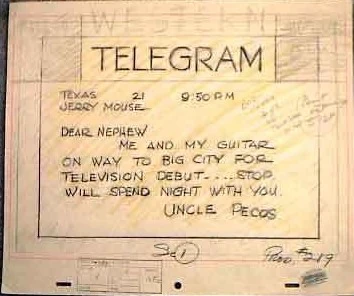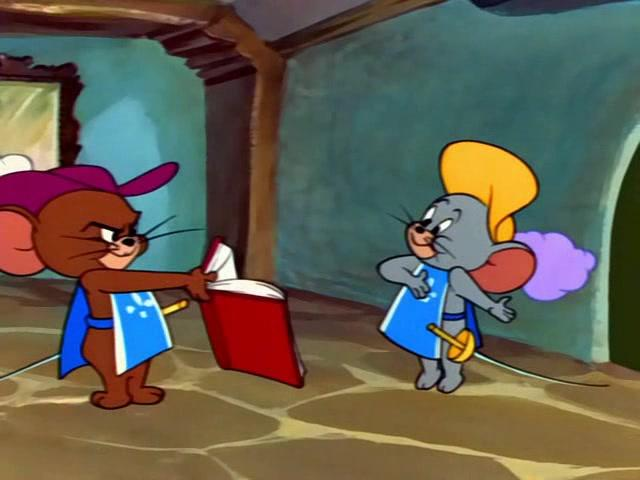
This short film marked the last of the Hanna and Barbera directed shorts to not be in Cinemascope and the last Tom and Jerry cartoon to be produced by Fred Quimby. William Hanna and Joseph Barbera would take over the producing these cartoons (and other MGM cartoons like the Droopy shorts) after their next film (the non-Tom and Jerry cartoon, Good Will to Men). Pecos Pest also marks the 96th Tom and Jerry cartoon overall.
In this short film, Jerry's folk-singing Uncle Pecos comes to visit. He is going to perform on TV the next night and spends his whole visit practicing. Unfortunately, his guitar strings keep breaking. He pulls off Tom's whiskers to use as his guitar strings.
This is a fun cartoon. This film mostly benefits from Uncle Pecos being a really fun character. His singing and guitar playing are very enjoyable to listen to and how he never lets anything stop him from performing his song makes him kind of appealing. His whole gimmick of using Tom's whiskers as guitar strings allows for some good slapstick gags. Few of these gags are laugh out loud funny but most of them made me at least chuckle. The ending gag though is fantastic.
The song Uncle Pecos is singing is the old folk song, Froggie Went a Courtin. The words to this song originally appeared as a poem (called The Frog Came to the Myl Dur) in 1548 in Wedderburn’s Complaynt of Scotland. The first musical version appeared in Thomas Ravenscroft's 1611 collection of folk music, Melismata. In 1928 Chubby Parker (a star on WLS Barn Dance in Chicago) recorded a country version of this song. In 1940's Burl Ives recording a very popular version of this song. Folk singers like Woody Guthrie and Pete Seeger would make recordings of this song as well. perhaps inspired by those versions, Bob Dylan would record this song on his 1992 album, Good as I've Been to You. Bruce Springsteen would record this song on his 2006 album, We Shall Overcome: The Seeger Sessions.
Providing the singing voice for Uncle Pecos was Shug Fisher. In 1937 he was recorded by Decca as Hugh and Shug’s Radio Pals. In 1943, he became a member of the Sons of the Pioneers when Pat Brady and Lloyd Perryman were drafted. He not only sang with the group, but he also wrote some of their songs including Out on The Open Range, Ridin' Down To Santa Fe and Forgive and Forget. He is a familiar presence to fans of old B-Westerns, appearing in many including quite a few with Roy Rogers. He would continue acting in westerns into the TV era and appeared on many episodes of Gunsmoke. He also had a nightclub act around this time. Bill Hanna and Joseph Barbera caught this nightclub act and decided to build a cartoon around it. This cartoon was not the first time that Shug Fisher had recorded Froggie Went a Courtin'. He had earlier sung the song on the Sons of the Pioneers' Luck-U Ranch radio program in 1951. You can listen to that below.
Though Uncle Pecos only appeared in one theatrical cartoon short, he has remained a fan favorite. He would later star in an episode of TV's Tom and Jerry Tales entitled Cry Uncle (2006). He would also appear in mulitple episodes of TV's The Tom and Jerry Show including I Quit (2017), Uncle Pecos Rides Again (2018), Cat-a-Tonic Mouse (2018), (Not) Your Father's Mouse-Stache (2021), Attachment Disorder (2020) and The Not So Ugly Duckling (2021). Clips from Pecos Pest are reused in Uncle Pecos Rides Again. He also had a non-speaking cameo in the direct to video feature film, Tom and Jerry: Cowboy Up! (2022).
The credited animators on this film are Ed Barge, Irven Spence, Ray Patterson and Kenneth Muse. Robert Gentle was the credited background artist. The cartoon is available on the DVD set, Tom and Jerry Spotlight Collection Vol. 1.

Below is a layout drawing for the telegram seen in this film.

-Michael J. Ruhland
Resources Used
https://tomandjerry.fandom.com/wiki/Pecos_Pest
https://cartoonresearch.com/index.php/a-musical-up-roar-1954-57/
https://allnurseryrhymes.com/frog-went-a-courtin/#:~:text=Originally%20from%20Scotland%2C%20%E2%80%9CFroggy%20Went%20A%20Courtin%E2%80%9D%20is,was%20first%20recorded%20by%20Thomas%20Ravenscroft%20in%201611.
https://folklore.usc.edu/frog-went-a-courtin-english-language-folk-song/


















